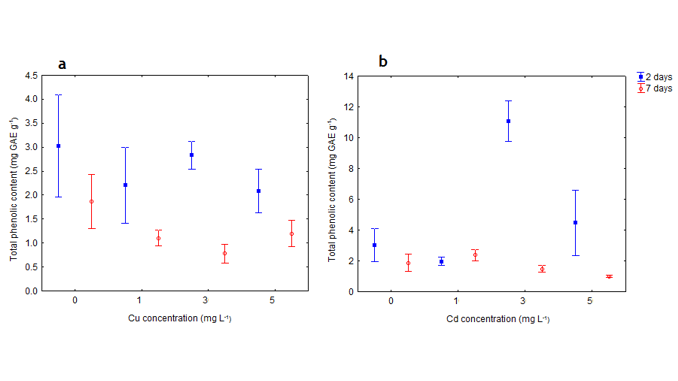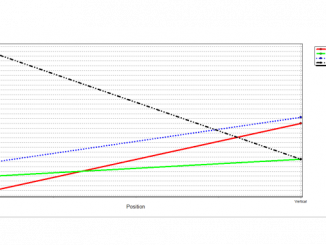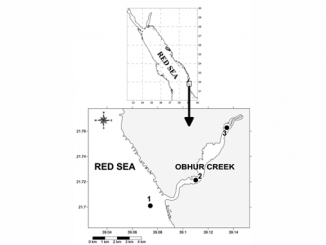
Paper category: Original research paper
Corresponding author: Sathianeson Satheesh (satheesh_s2005@yahoo.co.in)
DOI: 10.1515/ohs-2021-0017
Received: 02/10/2020
Accepted: 15/12/2020
Full text: here
Citation (APA style): Al-Khaldi,W.,Al Solami,L. & Satheesh,S.(2021).Effects of copper and cadmium on physiology and antifouling defense of the marine macroalga Ulva reticulata. Oceanological and Hydrobiological Studies,50(2) 184-197. https://doi.org/10.2478/oandhs-2021-0017
Abstract
Heavy metals are major stressors for benthic macroalgal communities in marine ecosystems. In this study, the effects of copper and cadmium on some physiological parameters along with antifouling defense of the marine macroalga Ulva reticulata were assessed under laboratory conditions. Macroalgal samples were treated with three concentrations (1 mg l−1, 3 mg l−1 and 5 mg l−1) of copper and cadmium for 2 and 7 days. After treatment, algal samples were analyzed for chlorophyll-a, carotenoid, total polyphenol and total antioxidant capacity. Also, algal extracts were tested against biofilm-forming bacteria strains to understand differences in antifouling activity. The results indicated that exposure of U. reticulata to copper and cadmium, on the one hand, induced protective mechanisms such as total phenol production and antioxidant capacity against metal stress and, on the other hand, reduced photosynthesis. While the extract obtained from control algal samples showed a strong inhibitory effect on the growth of biofilm-forming bacteria, treatment with heavy metals resulted in reduced antibiofilm activity. In general, the results revealed that exposure of macroalgae to heavy metals can affect antifouling defense traits in addition to changes in photosynthetic pigment content.
Acknowledgements
We thank the Faculty of Marine Sciences, King Abdulaziz University for providing necessary facilities.
References
Ahmad, P., Jaleel, C.A., Salem, M.A., Nabi, G. & Sharma, S. (2010). Roles of enzymatic and nonenzymatic antioxidants in plants during abiotic stress. Crit. Rev. Biotechnol. 30: 161–175. DOI: 10.3109/07388550903524243.
Alsaafani, M.A., Alraddadi, T.M. & Albarakati, A.M. (2017). Seasonal variability of hydrographic structure in Sharm Obhur and water exchange with the Red Sea. Arab. J. Geosci. 10: 315. DOI: 10.1007/s12517-017-3108-8.
Balqadi, A.A., Salama, A.J. & Satheesh, S. (2018). Microfouling development on artificial substrates deployed in the central Red Sea. Oceanologia 60: 219–231. DOI: 10.1016/j.oceano.2017.10.006.
Brodie, J., Maggs, C.A. & John, D.M. (2007). Green seaweeds of Britain and Ireland. pp. [i–v], vi–xii, 1–242, 101 figs. London: British Phycological Society.
Chan, S.M., Wang, W. & Ni, I. (2003). The uptake of Cd, Cr, and Zn by the macroalga Enteromorpha crinita and subsequent transfer to the marine herbivorous rabbitfish, Siganus canaliculatus. Arch. Environ. Contam. Toxicol. 44: 298–306.
Collen, J. & Davison, I.R. (1999). Reactive oxygen production and damage in intertidal Fucus spp. (Phaeophyceae). J. Phycol. 35: 54–61. DOI: 10.1046/j.1529-8817.1999.3510054.x.
Contreras, L., Medina, M.H., Andrade, S., Oppliger, V. & Correa, J.A. (2007). Effects of copper on early developmental stages of Lessonia nigrescens Bory (Phaeophyceae). Environ. Pollut. 145: 75–83. DOI: 10.1016/j.envpol.2006.03.051.
Contreras, L., Mella, D., Moenne, A. & Correa, J.A. (2009). Differential responses to copper-induced oxidative stress in the marine macroalgae Lessonia nigrescens and Scytosiphon lomentaria (Phaeophyceae)
Contreras-Porcia, L., Meynard, A., López-Cristoffanini, C., Latorre, N. & Kumar, M. (2017). Marine metal pollution and effects on seaweed species. In M. Kumar & P. Ralph (Eds.), Systems Biology of Marine Ecosystems (pp. 35–48). Cham: Springer. DOI: 10.1007/978-3-319-62094-7_3.
Cronin, G. & Hay, M.E. (1996). Induction of seaweed chemical defenses by amphipod grazing. Ecology 77: 287–301. DOI: 10.2307/2265731.
da Costa, C.H., Perreault, F., Oukarroum, A., Melegari, S.P., Popovic, R. et al. (2016). Effect of chromium oxide (III) nanoparticles on the production of reactive oxygen species and photosystem II activity in the green alga Chlamydomonas reinhardtii. Sci. Total Environ. 565: 951–960. DOI: 10.1016/j.scitotenv.2016.01.028.
Da Gama, B.A.P., Plouguerné. E. & Pereira, R.C. (2014). The antifouling defence mechanisms of marine macroalgae. Adv. Bot. Res. 71: 413–440. DOI: 10.1016/B978-0-12-408062-1.00014-7.
Da Gama, B.A.P., Santos, R.P.A. & Pereira, R.C. (2008). The effect of epibiosis on the susceptibility of the red seaweed Cryptonemia seminervis to herbivory and fouling. Biofouling 24: 209–218. DOI: 10.1080/08927010802041253.
Dhargalkar, V.K. & Kavlekar, D.P. (2004). Seaweeds-a field manual (pp. 36). National Institute of Oceanography, Goa, India.
Dos Santos, R.W., Schmidt, E.C., Martins, R.P., Latini, A., Maraschin, M. et al. (2012). Effects of cadmium on growth, photosynthetic pigments, photosynthetic performance, biochemical parameters and structure of chloroplasts in the Agarophyte Gracilaria domingensis (Rhodophyta, Gracilariales). Am. J. Plant Sci. 3: 1077–1084. DOI: 10.4236/ajps.2012.38129.
Faÿ, F., Gouessan, M., Linossier, I. & Réhel, K. (2019). Additives for efficient biodegradable antifouling paints. Int. J. Mol. Sci. 20: 361. DOI: 10.3390/ijms20020361.
Flouty, R. & Estephane, G. (2012). Bioaccumulation and biosorption of copper and lead by a unicellular algae Chlamydomonas reinhardtii in single and binary metal systems: A comparative study. J. Environ. Manage. 111: 106–114. DOI: 10.1016/j.jenvman.2012.06.042.
Foyer, C.& Noctor, G. (2011). Ascorbate and glutathione: The heart of the redox hub. Plant Physiol. 155: 2–8. DOI: 10.1104/pp.110.167569.
Fu, C.W.F., Ho, C.W., Yong, W.T.L., Abas, F. & Tan, C.P. (2015). Effects of phenolic antioxidants extraction from four selected seaweeds obtained from Sabah. PeerJ 3: p.e1249v1. DOI: 10.7287/peerj.preprints.1249v1.
Ganesan, P., Kumar, C.S. & Bhaskar, N. (2008). Antioxidant properties of methanol extract and its solvent fractions obtained from selected Indian red seaweeds. Bioresour. Technol. 99: 2717–2723. DOI: 10.1016/j.biortech.2007.07.005.
Gouveia, C., Kreusch, M., Schmidt, É.C., Marthiellen, R.D.L., Osorio, L.K. et al. (2013). The effects of lead and copper on the cellular architecture and metabolism of the red alga Gracilaria domingensis. Microsc. Microanal. Microstruct. 19: 513–524. DOI: 10.1017/S1431927613000317.
Gressler, V., Fujii, M.T., Martins, A.P., Colepicolo, P. & Pinto, P. (2011). Biochemical composition of two seaweed species grown on the Brazilian coast. J. Sci. Food Agric. 91: 1687–92. DOI: 10.1002/jsfa.4370.
Han, T.W., Tseng, C.C., Cai, M., Chen, K., Cheng, S.Y. et al. (2020). Effects of cadmium on bioaccumulation, bioabsorption, and photosynthesis in Sarcodia suiae. Int. J. Environ. Res. Public Health 17: 1294. DOI: 10.3390/ijerph17041294.
Huang, X., Ke, C. & Wang, W.X. (2010). Cadmium and copper accumulation and toxicity in the macroalga Gracilaria tenuistipitata. Aquat. Biol. 11: 17–26. DOI: 10.3354/ab00288.
Ismail, G.A. & Ismail, M.M. (2017). Variation in oxidative stress indices of two green seaweeds growing under different heavy metal stresses. Environ. Monit. Assess. 189: 68. DOI: 10.1007/s10661-017-5775-z.
Jeffrey, S.T. & Humphrey, G.F. (1975). New spectrophotometric equations for determining chlorophylls a, b, c1 and c2 in higher plants, algae and natural phytoplankton. Biochem. Physiol. Pflanz. 167: 191–194.
Ji, Y., Xie, X.J. & Wang, G.G. (2018). Effects of the heavy metal cadmium on photosynthetic activity and the xanthophylls cycle in Phaeodactylum tricornutum. J. Oceanol. Limnol. 36: 2194–2201. DOI: 10.1007/s00343-019-7160-y.
Jiang, H.P., Gao, B.B., Li, W.H., Zhu, M., Zheng, C.F. et al. (2013). Physiological and biochemical responses of Ulva prolifera and Ulva linza to cadmium stress. Sci. World J. 2013: 289537. DOI: 10.1155/2013/289537.
Jormalainen, V. & Honkanen, T. (2008). Macroalgal chemical defenses and their roles in structuring temperate marine communities. In C. Amsler (Ed.), Algal Chemical Ecology (pp. 57–89). Berlin: Springer. DOI: 10.1007/978-3-540-74181-7_3.
Kapkov, V.I., Belenikina, O.A. & Fedorov, V.D. (2011). Effect of heavy metals on marine phytoplankton. Mosc. Univ. Biol. Sci. Bull. 66: 32–36.
Kokilam, G. & Vasuki, S. (2014). Biochemical and phytochemical analysis on Ulva fasciata and Caulerpa taxifolia. Int. J. Pharm. 4: 7–11.
Krämer, U. & Clemens, S. (2006). Functions and homeostasis of zinc, copper, and nickel in plants. In M.J. Tamás & E. Martinoia (Eds.), Molecular Bology of Metal Homeostasis and Detoxification from Microbes to Man (pp. 214–272). Berlin: Springer-Verlag. DOI: 10.1007/4735_96.
Leal, P.P., Hurd, C.L., Sander, S.G., Armstrong, E., Fernández, P.A. et al. (2018). Copper pollution exacerbates the effects of ocean acidification and warming on kelp microscopic early life stages. Sci. Rep. 8: 1–13. DOI: 10.1038/s41598-018-32899-w.
Lozano-Bilbao, E., Díaz, Y., Lozano, G., Jurado-Ruzafa, A., Hardisson, A. et al. (2019). Metal content in small pelagic fish in the north-west Africa. Thalassas 35: 643–653. DOI: 10.1007/s41208-019-00141-7.
Lürling, M.F.L.L.W. (2012). Infodisruption: pollutants interfering with the natural chemical information conveyance in aquatic systems. In C. Brönmark & L.A. Hansson (Eds.), Chemical Ecology in Aquatic Systems (pp. 250–271). Oxford university press. DOI: 10.1093/acprof:osobl/9780199583096.001.0001.
Mannino, A.M. & Micheli, C. (2020) Ecological function of phenolic compounds from Mediterranean fucoid algae and seagrasses: An overview on the genus Cystoseira sensu lato and Posidonia oceanica (L.). J. Mar. Sci. Eng. 8: 19. DOI: 10.3390/jmse8010019.
Martins, C.D., Arantes, N., Faveri, C., Batista, M.B., Oliveira, E.C. et al. (2012). The impact of coastal urbanization on the structure of phytobenthic communities in southern Brazil. Mar. Pollut. Bull. 64: 772–778. DOI: 10.1016/j.marpolbul.2012.01.031.
Nylund, G.M., Enge, S. & Pavia, H. (2013). Costs and benefits of chemical defence in the red alga Bonnemaisonia hamifera. PloS one 8: e61291 . DOI: 10.1371/journal.pone.0061291.
Ozsoy, N., Can, A., Yanardag, R. & Akev, N. (2008). Antioxidant activity of Smilax excelsa L. leaf extracts. Food Chem. 110: 571–583.
Paul, V.J., Cruz-Rivera, E. & Thacker, R.W. (2001). Chemical mediation of macroalgal-herbivore interactions: ecological and evolutionary perspectives. In J.B. McClintock & B.J. Baker (Eds.), Marine Chemical Ecology (pp. 227–265). Boca Raton, Florida: CRC Press.
Paul, V.J., Puglisi, M.P. & Ritson-Williams, R. (2006). Marine chemical ecology. Nat. Prod. 23: 153–180.
Payne, C.D. & Price, N.M. (1999). Effects of cadmium toxicity on growth and elemental composition of marine phytoplankton. J. Phycol. 35: 293–302.
Pereira, D.T., Simioni, C., Filipin, E.P., Bouvie, F., Ramlov, F. et al. (2017). Effects of salinity on the physiology of the red macroalga, Acanthophora spicifera (Rhodophyta, Ceramiales). Acta Bot. Bras. 31: 555–565. DOI: 10.1590/0102-33062017abb0059.
Pereira, R.C. & Da Gama, B.A.P. (2008). Macroalgal chemical defenses and their roles in structuring tropical marine communities. In C. Amsler (Ed.), Algal Chemical Ecology (pp. 25–55). Berlin: Springer.
Phillips, D.J.H. (1990). Use of macroalgae and invertebrates as monitors of metal levels in estuaries and coastal waters. In R.W. Furness & P.S. Rainbow (Eds.), Heavy Metals in the Marine Environment (pp. 81–99). Florida: CRC Press.
Pinto, E., Carvalho, A.P., Cardozo, K.H.M., Malcata, F.X., Anjos, F.M.D. et al. (2011). Effects of heavy metals and light levels on the biosynthesis of carotenoids and fatty acids in the macroalgae Gracilaria tenuistipitata (var. liui Zhang & Xia). Rev. Bras. Farmacogn. 21: 349–354. DOI: 10.1590/S0102-695X2011005000060.
Pise, N.M., Gaikwad, D.K. & Jagtap, T.G. (2013). Oxidative stress and antioxidant indices of the marine red alga Porphyra vietnamensis. Acta Bot. Croat. 72: 197–209.
Polo, L.K., De, L., Felix, M.R., Kreusch, M., Pereira, D.T. et al. (2014). Photoacclimation responses of the brown macroalga Sargassum cymosum to the combined influence of UV radiation and salinity: cytochemical and ultrastructural organization and photosynthetic performance. Photochem. Photobiol. 90: 560–573. DOI: 10.1111/php.12224.
Prieto, P., Pineda, M. & Aguilar, M. (1999). Spectrophotometric quantification of antioxidant capacity through the formation of a phosphomolybdenum complex: specific application to the determination of vitamin E. Anal. Biochem. 269: 337–341.
Ramalhosa, P., Debus, S.L., Kaufmann, M. & Lenz, M. (2017). A non-native macroalga is less attractive for herbivores but more susceptible to light limitation and grazing stress than a comparable native species. Helgol. Mar. Res. 70: 25. DOI: 10.1186/s10152-016-0478-3.
Ramlov, F., Carvalho, T.J.G., Schmidt, É.C., Martins, C.D.L., Kreusch, M.G. et al. (2014). Metabolic and cellular alterations induced by diesel oil in Hypnea musciformis (Wulfen) JV Lamour.(Gigartinales, Rhodophyta). J. Appl. Phycol. 26: 1879–1888.
Rybak, A., Messyasz, B. & Łęska, B. (2012). Freshwater Ulva (Chlorophyta) as a bioaccumulator of selected heavy metals (Cd, Ni and Pb) and alkaline earth metals (Ca and Mg). Chemosphere 89: 1066–1076. DOI: 10.1016/j.chemosphere.2012.05.071.
Sáez, C.A., Lobos, M.G., Macaya, E.C., Oliva, D., Quiroz, W. et al. (2012). Variation in patterns of metal accumulation in thallus parts of Lessonia trabeculata (Laminariales; Phaeophyceae): implications for biomonitoring. PloS one 7: e50170. DOI: 10.1371/journal.pone.0050170.
Salama, A.J., Satheesh, S. & Balqadi, A.A. (2018). Development of Biofouling Communities on Nylon Net Panels Submerged in the Central Red Sea: Effects of Season and Depth. Thalassas 34: 199–208. DOI: 10.1007/s41208-017-0052-z.
Saleh, B. (2015). Physiological response of the green algae Ulva lactuca (Chlorophyta) to heavy metals stress. J. Stress Physiol. 11: 38–51.
Scherner, F., Horta, P.A., de Oliveira, E.C., Simonassi, J.C., Hall-Spencer, J.M. et al. (2013). Coastal urbanization leads to remarkable seaweed species loss and community shifts along the SW Atlantic. Mar. Pollut. Bull. 76: 106–115. DOI: 10.1016/j.marpolbul.2013.09.017.
Schiel, D.R. & Foster, M.S. (2015). The biology and ecology of giant kelp forests (First edition) p 416. Oakland, CA: University of California Press.
Seepersaud, M.A., Ramkissoon, A., Seecharan, S., Powder-George, Y.L. & Mohammed, F.K. (2018). Environmental monitoring of heavy metals and polycyclic aromatic hydrocarbons (PAHs) in Sargassum filipendula and Sargassum vulgare along the eastern coastal waters of Trinidad and Tobago, West Indies. J. Appl. Phycol. 30: 2143–2154. DOI: 10.1007/s10811-017-1372-3.
Singleton, V.L. & Rossi, J.A. (1965). Colorimetry of total phenolics with phosphomolybdic-phosphotungstic acid reagents. Am. J. Enol. Viticult. 16: 144–158.
Sudatti, D.B., Fujii, M.T., Rodrigues, S.V., Turra, A. & Pereira, R.C. (2018). Prompt induction of chemical defenses in the red seaweed Laurencia dendroidea: The role of herbivory and epibiosis. J. Sea Res. 138: 48–55. DOI: 10.1016/j.seares.2018.04.007.
Tabudravu, J.N., Gangaiya, P., Sotheeswaran, S. & South, G.R. (2002). Enteromorpha flexuosa (Wulfen) J. Agardh (Chlorophyta: Ulvales) – evaluation as an indicator of heavy metal contamination in a tropical estuary. Environ. Monit. Assess. 75: 201–213.
Topcuoglu, S., Ergül, H.A., Baysal, A., Ölmez, E. & Kut, D. (2003). Determination of radionuclide and heavy metal concentrations in biota and sediment samples from Pazar and Rize stations in the eastern Black Sea. Fresen Environ. Bull. 12: 695–699.
Torres, P.B., Chow, F., Furlan, C.M., Mandelli, F., Mercadante, A. et al. (2014). Standardization of a protocol to extract and analyze chlorophyll a and carotenoids in Gracilaria tenuistipitata Var. Liui. Zhang and Xia (Rhodophyta). Brazilian J. Oceanogr. 62: 57–63.
Toth, G. & Pavia, H. (2000). Lack of phlorotannin induction in the brown seaweed Ascophyllum nodosum in response to increased copper concentrations. Mar. Ecol. Prog. Ser. 192: 119–126.
Tzafriri-Milo, R., Benaltabet, T., Torfstein, A. & Shenkar, N. (2019). The potential use of invasive ascidians for biomonitoring heavy metal pollution. Front Mar. Sci. 6: 611. DOI: 10.3389/fmars.2019.00611.
Tzure-Meng, W.U., Yi-Ting, H.S.U. & Tse-Min, L.E.E. (2009). Effects of cadmium on the regulation of antioxidant enzyme activity, gene expression, and antioxidant defenses in the marine macroalga Ulva fasciata. Bot. Stud. 50: 25–34.
Volesky, B. & Holan, Z.R. (1995). Biosorption of heavy metals. Biotechnol. Prog. 11: 235–250.
Wang, Z., Wang, X. & Ke, C. (2014). Bioaccumulation of trace metals by the live macroalga Gracilaria lemaneiformis. J. Appl. Phycol. 26: 1889–1897. DOI: 10.1007/s10811-013-0222-1.
Warneke, A.M. & Long, J.D. (2015). Copper contamination impairs herbivore initiation of seaweed inducible defenses and decreases their effectiveness. PloS one 10: e0135395. .DOI: 10.1371/journal.pone.0135395.
Webster, E.A., Murphy, A.J., Chudek, J.A. & Gadd, G.M. (1997). Metabolism-independent binding of toxic metals by Ulva lactuca: cadmium binds to oxygen-containing groups, as determined by NMR. BioMetals 10: 105–117.
Wu, X.J. & Hansen, C. (2008). Antioxidant capacity, phenolic content, polysaccharide content of Lentinus edodes grown in whey permeate based submerged culture. J. Food Sci. 73: M1–M8.
Xia, J.R., Li, Y.J., Lu, J. & Chen, B. (2004). Effects of copper and cadmium on growth, photosynthesis. Bull. Environ. Contam. Toxicol. 73: 979–986.
Yadav, S. (2010). Heavy metal toxicity in plants: An overview on the role of glutathione and phytochelatins in heavy metal stress in plants. S. Afr. J. Bot. 76: 167–179. DOI: 10.1016/j.sajb.2009.10.007.
Yates, J.L. & Peckol, P. (1993). Effects of nutrient availability and herbivory on polyphenolics in the seaweed Fucus. Ecology 74: 1757–1766.
Zhang, W., Duan, X., Huang, H., Zhang, Y. & Wang, B. (2007). Evaluation of 28 marine algae from the Qingdao coast for antioxidative capacity and determination of antioxidant efficiency and total phenolic content of fractions and subfractions derived from Symphyocladia latiuscula (Rhodomelaceae). J. Appl. Phycol. 19: 97–108.
Zhu, X., Zou, D., Huang, Y., Cao, J., Sun, Y. et al. (2017). Physiological responses of Porphyra haitanensis (Rhodophyta) to copper and cadmium exposure. Bot. Mar. 60: 27–37. DOI: 10.1515/bot-2016-0117.



